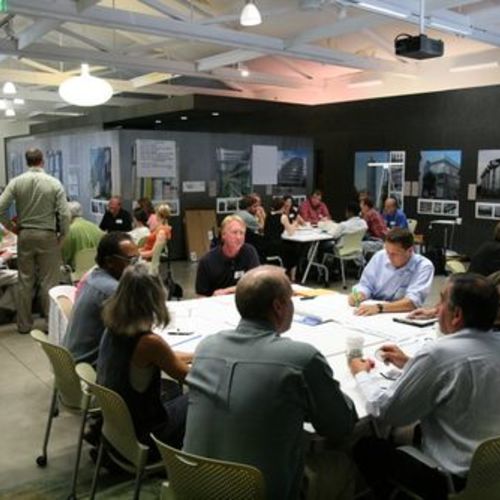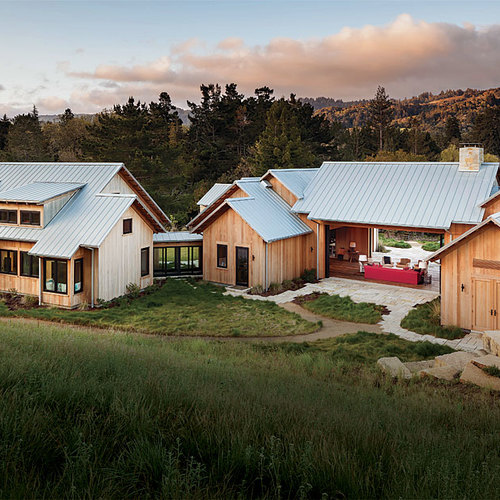
I find myself uttering the words, “Yes, yes!” when talking with Mel Baiser of Helm Construction Solutions in Brattleboro, Vermont. The things Mel says make such good sense, yet the consulting firm’s model for design-build projects is rarely seen at work in the industry. At the start of our call, I had to confess my confusion around Helm’s services. Mel is so versed in building science that I was under the impression they were a construction company. In truth, their purview includes working with contractors, architects, homeowners, business owners, and institutions to advance high-performance building practices and triple-bottom-line principles. In short, they offer a model of doing business that results in some of the most holistic projects I’ve come across.
During a previous conversation, Mel had mentioned cost estimation and value engineering as among the skills they help builders hone. I was curious to learn more about their process for guiding people and projects from concept to completion—on budget. They follow a Integrated Project Delivery (IPD)−inspired model, which, Mel explains, is a direct response to over a decade spent in San Francisco working as a carpenter, estimator, and project manager for several high-end remodeling companies. Mel experienced the same scenario again and again, whereby clients hired architects, shared their vision and budget, and when builders were brought in to bid it (which they typically did for free), the numbers came in way over budget. The result was nearly always the same: the client got angry at the builder for the higher figure; and they wanted the builder to reprice and value engineer new iterations—again, unpaid. It was a frustrating approach that Mel tired of seeing repeated.
Better than design-bid-build
In contrast, the IPD model works because the builder is brought in at the start.…
Weekly Newsletter
Get building science and energy efficiency advice, plus special offers, in your inbox.

This article is only available to GBA Prime Members
Sign up for a free trial and get instant access to this article as well as GBA’s complete library of premium articles and construction details.
Start Free TrialAlready a member? Log in














8 Comments
Hats off to Mel! I have been preaching that the way we deliver buildings is broken for years. What Mel has described reminds me of convergent evolution in the sense that our company has been doing for years- almost verbatim- what Mel is describing. It's a great feeling to see another similar example out in the world of one's process that one has spent years refining. It makes me feel like there is really something here of value that we 'converged' on almost the exact same project delivery method based on the same inputs. I too, had seen way too many fully flushed out architectural plans (aka 'funny papers') that were often 2 or 3x the client's highest number in their head.
This method not only results in a better project and manages expectations for all parties throughout, but allows the clients to be an integral part of the team as the IDP process informs the client of pros and cons of any particular decision and allows them to make educated choices. There is a sense of teamwork and pride that come from this that really makes for long term relationships (and great referrals down the road). This method is, in my opinion, also critical for high performance building as one has multiple opportunities to value engineer performance characteristics with input from the build side as the building is designed. I firmly believe this is the best way to deliver a high performing home at the best price (actually, value).
We need to see more of this in our industry. Thanks Kiley and Mel for the great article!
Coming from the architectural side of it... we are equally frustrated by the scenario you describe! I think it really is a structural challenge with the design-bid-build method of project delivery.
We need input from contractors to develop useful budgets. And when the contractors aren't being paid during schematic design in a traditional design-bid-build project delivery, it is difficult (and unfair) to ask contractors to put in the work necessary to have successful collaborative designs that put the clients money to its most effective uses and develop realistic expectations with the client for how far their money will go!
Design-bid-build perhaps is appropriate for clients who know what they want, who have flexible budgets (since you don't get good cost information until late in the process), but do want to make sure they are getting a the best price for the design (due to the competitive bid).
For clients with a more rigid budget (which is many of them!), getting a contractor under contract early in the process to allow for real cost feedback at the point in the design process when that feedback can be acted upon most effectively, and to reduce budgetary surprises may be well worth giving up the competitive bidding of design-bid-build.
And from the design side, it seems to me that the more collaborative the relationship between the owner, architect and contractor, the better the design!
It is remarkably challenging to overcome the inertia of the typical way things are done, even when all the parties involved generally agree that its not the most optimal way to do things!
I think we don't talk nearly enough about project delivery methods. When studying for the architectural exams, I recall studying a little table that listed out a whole bunch of delivery methods (design-bid-build, design-build, construction-manager-as-advisor, construction-manager-as-constructor, integrated project delivery, etc. etc.) and looked at the different tradeoffs in terms of risk for time, cost, quality, etc. All the methods have pros and cons, and using the method that is right for the needs of the project makes a lot of sense, but it requires a great deal of project management agility to be able to do that!
I love that we have a builder, an architect, and an owner commenting here on this topic! While historically these players have been pitted against one another, we all do really have a lot in common and if we can set up process and delivery methods that put at the center our collective goals, I think we can keep getting better. Of course, accountability and checks and balances are still important. I appreciate that you brought up that different types of projects and drivers should impact what delivery method is selected for a given project. The process I spoke with Kiley about above is really helpful for budget-driven projects. Though the truth is that even residential projects with a 5 million dollar budget, are still often budget-driven :) Projects being fast tracked where budget is less of a concern may involve fewer cost interventions. Getting the entire team up to speed on what the client goals and priorities are first and then developing an agreement on the most appropriate delivery method and contract type, should be a key part of every first team meeting. Thanks for reading and weighing in. We have a lot of client education to do as well.
Thanks for your comment, Joshua! Clearly great minds like alike :). In all seriousness, we of course did not invent these concepts but are reacting to our lived experiences, making it up as we go, learning from others and our own mistakes, reflecting, reinventing, and repeating. It makes a lot of sense that high-performance (and low-carbon) building demands a higher level of cooperation and coordination than some of the building practices of the past. And for many of us in this industry who are committed to slowing climate change and building a better world, we find ourselves working from a climate justice lens and exploring the process by which design and construction happen as much as focusing on the product. How we treat one another and our relationships throughout the process are often as important as what is ultimately built. Thanks for reading and for trying to find better ways of doing construction!
great read, thanks for this article. As an owner, I ran into these chicken and egg issues in quoting things vs design all the time and at least in theory this sort of third party estimating sounds great to have as a resource. I would often get the reply that for a quote even approaching reality, they need to see construction drawings. But getting those construction drawings means that you already put a great deal of money into getting those CDs, often based on very rough estimates from the designer that may have no basis in reality in your local market. I have to wonder what the pitfalls of this approach are, however, as you are still largely relying on the hunch of a third party contractor in your local area that does not have the construction drawings for reference.
In a way I think I did this by doing a "pre-construction" contract with local contractors to estimate the costs of the build while working with the architect. However, I used two contractors for this and it's not clear that the first was at all like the second, which points to these pre-construction estimates being very specific to the builder and thus of questionable value as a true third party resource. You then still have the issue of what you are really getting for those quotes, since there is often a lot of wiggle room for quality of craft and materials.
Carson, I'm so glad you brought up this perspective. One of the challenges with this approach (and there are several) is that not every builder knows how to estimate. In fact, I'd argue that most do not know how to estimate accurately. At times, HELM is involved as a third party hired by the Owner directly. Sometimes we are brought in as part of the Architect's team. Often, we are contracting directly for the builder and working in collaboration with them as their estimator and project manager. Regardless of how we come to the table, what allows us to have success with this process (not that we are perfect - we still face challenges and make mistakes too) is that we are skilled in estimating. As we work to promote this concept in our industry, it absolutely requires a few things:
1. Builders need to learn how to estimate (unless they have clients who are just ok with t & m and no limits and no job cost reporting).
2. Builders need to know their numbers and what markups are appropriate for their particular business.
3. Architects should work with Owners to help pre-qualify the best contractor for the job not soley based on price. As owner's reps there is a slew of questions we can ask to disqualify a builder who may not be the right fit for a job.
4. Compensating builders for their time to do cost planning, engage subs and vendors, and value engineering allows the contractor the time and capacity that it needs to spend putting together a real and detailed budget.
5. A builder's estimate is only as accurate as the information provided. If an Architect has not provided a good set of plans and specs - or more commonly, if a client has not been willing to pay an architect to provide a good set of plans and specs, then the estimate will only be somewhat accurate.
Not all builders have dialed in a good process for providing preliminary cost estimates from schematic plans. It requires having good job cost accounting practices in place and years of being in operation, pricing jobs, and analyzing costs. Nevertheless, we know that this is the chicken and egg issue that we need to help crack to provide the most value to clients trying to understand how to design something within their means. I'm hopeful for where we are headed with it. Thanks for your comments and for reading :)
thanks for the reply Mel, hopefully this will help the industry's cost estimation process become more standardized and transparent to owners/builders. It's a completely different world than people are used to these days where you can look up the price of practically anything online and view charts of price changes over the past year. Even just having the data logged by the local builders association would be a huge asset.
Agree w/ Mel about estimating. Not sure how good I am at it.
Some contractors are putting prices right on their websites. Or at least a range of prices for certain project. The problem is the variables quickly pile up with a project of any complexity. So the range has to be so wide that it may not be helpful anymore.
I sometimes try to pull up what I think is a roughly similar job, if I have one, do a quick report of my costs, and try to update them for todays labor and material prices. An inexact science to be sure. Especially with the incredibly volatile price of framing lumber and some other materials.
Log in or become a member to post a comment.
Sign up Log in